-
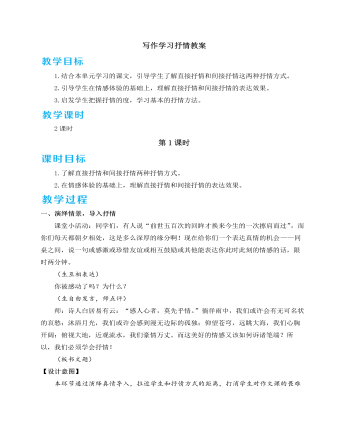
人教部编版七年级下册写作学习抒情教案
我们在湖边走着,在不高的山上走着。四周的风物秀隽异常。满盈盈的湖水一直溢拍到脚边,却又温柔地退回去了,像慈母抚拍着将睡未睡的婴儿似的,它轻轻地抚拍着石岸。水里的碎瓷片清晰可见。小小的鱼儿,还有顽健的小虾儿,都在眼前游来蹦去。登上了山巅,可望见更远的太湖。——郑振铎《石湖》(生根据师展示的原文,参考、揣摩名家笔下抒情方式的运用,体会抒情描写中以情动人的魅力)2.写一段话,抒发某种情感,如幸福、喜悦、痛苦、忧伤、渴望等。200字左右。提示:(1)可以描写场面、事物,也可以叙述故事;(2)情感的抒发要有内容,有凭借;(3)根据内容特点和表达需要,选择合适的抒情方式。(生自由习作后,小组内互评、修改)师小结:情贵在真,要注意抒发自己的真情实感。朱光潜曾说过:“作者自己如果没有感动,就绝对不能使读者感动。”在写作中,情感的抒发要自然,要水到渠成。
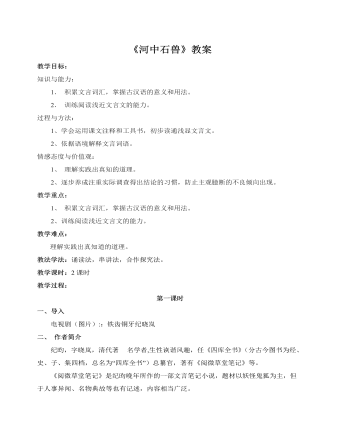
部编版语文七年级下册《河中石兽》教案
一、导入电视剧(图片)::铁齿铜牙纪晓岚 二、 作者简介纪昀,字晓岚,清代著 名学者,生性诙谐风趣,任《四库全书》(分古今图书为经、史、子、集四档,总名为“四库全书”)总纂官,著有《阅微草堂笔记》等。《阅微草堂笔记》是纪昀晚年所作的一部文言笔记小说,题材以妖怪鬼狐为主,但于人事异闻、名物典故等也有记述,内容相当广泛。三、感知课文 这篇课文讲了一个故事:有一个庙靠近河,庙门倒塌之后,门旁的两只石狮也掉到了河里。后来要修庙,决定要把石狮打捞上来。有人说,到下游去找,因为石狮被水冲走了,结果在下游没找到。一个读书人说,石狮肯定沉到沙泥里去了,因为石头重,沙泥轻,结果在庙前的沙泥里也没找到。一个老水手最后说,这两个石狮在上游,结果果然在上游打捞到了。 怎么会到上游去呢?阅读完课文后我们便知道了。反复朗读,读准字音
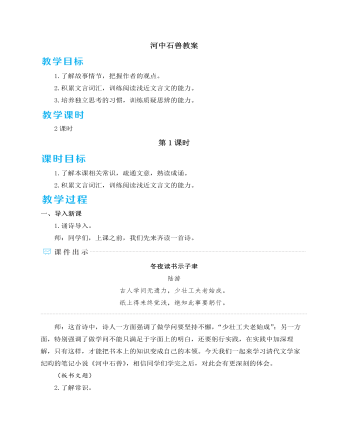
人教部编版七年级下册河中石兽教案
4.充当状语的名词和中心词之间要连读,即名词作状语时,一般在该词前停顿,且不能把状语与中心词读开。若分开读,就错将状语当成了主语,改变了句子的意思。5.“而”字后应该停顿。但“而”字在句中若起到下列作用,那么就不能停顿,也就是说,“而”字不能和后面的词语分开读,应该连读。(1)“而”在句中如果连接的是形容词(或副词)与动词,即“形容词(副词)+而+动词”,这时前边的形容词或副词充当状语,起修饰后面的动词的作用,不能分开读。(2)“而”在句中如果连接的是两个动词,即“动词+而+动词”,那么“而”表示顺承,也就是说,前面一个动作发生了,后面的动作紧接着就发生了,这时“而”后面就不能停顿,应和后面的动词连读。(3)“而”连接词性相同的两个词语(即两个名词、两个动词、两个形容词),表示并列,可译为“而且”“又”“和”或不译,这时“而”后不应该停顿。(4)“而”表示递进关系,可译为“而且”“并且”“就”或不译,这时“而”后不能停顿。
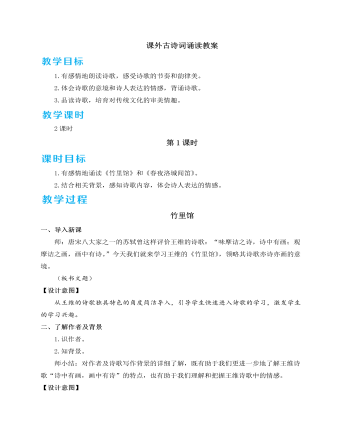
人教部编版七年级下册课外古诗词诵读教案
四、品读揣摩诗歌情志1.读出意境画面。师:请同学们以小组为单位,齐声朗读诗歌,然后合作交流,探究下面问题。(1)诗人用了哪些意象来表现晚春景色?诗人用了什么手法来写晚春景物?取得了怎样的艺术效果?(2)诗歌一、二句写出了怎样的晚春景致?请同学们用自己的语言描绘出来。(3)诗的三、四句意蕴深刻,为历代传诵。请从修辞手法的角度对这两句诗进行赏析。(生齐读后,小组交流、讨论问题,师指导明确)预设 (1)诗人用了草树、杨花、榆荚等意象表现晚春景色。一个“斗”字,运用拟人的修辞手法,把花朵人格化,形象生动地写出了晚春时节花草树木争芳斗艳的美丽景象。花草树木仿佛都有了情思,有了个性,成了精灵,使描绘的晚春景致生动而有情趣。

【高教版】中职数学拓展模块:3.1《排列与组合》优秀教学设计
教 学 过 程教师 行为学生 行为教学 意图时间 *揭示课题 3.1 排列与组合. *创设情境 兴趣导入 基础模块中,曾经学习了两个计数原理.大家知道: (1)如果完成一件事,有N类方式.第一类方式有k1种方法,第二类方式有k2种方法,……,第n类方式有kn种方法,那么完成这件事的方法共有 = + +…+(种). (3.1) (2)如果完成一件事,需要分成N个步骤.完成第1个步骤有k1种方法,完成第2个步骤有k2种方法,……,完成第n个步骤有kn种方法,并且只有这n个步骤都完成后,这件事才能完成,那么完成这件事的方法共有 = · ·…·(种). (3.2) 下面看一个问题: 在北京、重庆、上海3个民航站之间的直达航线,需要准备多少种不同的机票? 这个问题就是从北京、重庆、上海3个民航站中,每次取出2个站,按照起点在前,终点在后的顺序排列,求不同的排列方法的总数. 首先确定机票的起点,从3个民航站中任意选取1个,有3种不同的方法;然后确定机票的终点,从剩余的2个民航站中任意选取1个,有2种不同的方法.根据分步计数原理,共有3×2=6种不同的方法,即需要准备6种不同的飞机票: 北京→重庆,北京→上海,重庆→北京,重庆→上海,上海→北京,上海→重庆. 介绍 播放 课件 质疑 了解 观看 课件 思考 引导 启发学生得出结果 0 15*动脑思考 探索新知 我们将被取的对象(如上面问题中的民航站)叫做元素,上面的问题就是:从3个不同元素中,任取2个,按照一定的顺序排成一列,可以得到多少种不同的排列. 一般地,从n个不同元素中,任取m (m≤n)个元素,按照一定的顺序排成一列,叫做从n个不同元素中取出m个元素的一个排列,时叫做选排列,时叫做全排列. 总结 归纳 分析 关键 词语 思考 理解 记忆 引导学生发现解决问题方法 20

【高教版】中职数学拓展模块:3.3《离散型随机变量及其分布》教学设计
重点分析:本节课的重点是离散型随机变量的概率分布,难点是理解离散型随机变量的概念. 离散型随机变量 突破难点的方法: 函数的自变量 随机变量 连续型随机变量 函数可以列表 X123456p 2 4 6 8 10 12
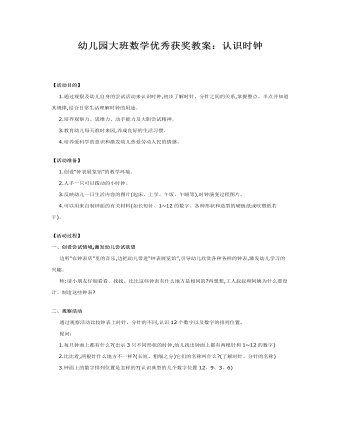
幼儿园大班数学优秀获奖教案:认识时钟
【活动准备】 1.创设“钟表展览馆”的教学环境。 2.人手一只可以拨动的小时钟。 3.反映幼儿一日生活内容的图片(起床、上学、午饭、午睡等),时钟演变过程图片。 4.可以用来自制钟面的有关材料(如长短针、1~12的数字、各种形状和造型的硬板纸或吹塑纸若干)。【活动过程】一、创设尝试情境,激发幼儿尝试欲望 边听“在钟表店”里的音乐,边把幼儿带进“钟表展览馆”,引导幼儿欣赏各种各样的钟表,激发幼儿学习的兴趣。 师:请小朋友仔细看看、找找、比比这些钟表有什么地方是相同的?再想想,工人叔叔和阿姨为什么要设计、制造这些钟表? 二、观察活动 通过观察活动比较钟表上时针、分针的不同,认识12个数字以及数字的排列位置。 提问: 1.每只钟面上都有什么?(出示3只不同形状的时钟,幼儿找出钟面上都有两根针和1~12的数字) 2.比比看,两根针什么地方不一样?(长短、粗细之分)它们的名称叫什么?(了解时针、分针的名称) 3.钟面上的数字排列位置是怎样的?(认识典型的几个数字位置12、9、3、6)

大班数学游戏教案:城堡夺旗(8的分合法)
准备:数字卡 棋盘 不同颜色的棋子 旋转六面体 各色旗 扑克牌 玩法:每组5名幼儿,一幅棋盘,每位幼儿一套1——7的扑克牌,每名幼儿持一粒不同颜色的棋子,将各自的棋子放在起点,按照自己的标志次序轮流掷旋转六面体,掷出数字几,就向前走几步,如果走到没有图案的格内,就让下一位幼儿掷旋转六面体;如果走到有图案的格子内,就大声说出图案的数量,并向其他幼儿提问该数字和哪一个数字合起来是8,然后与同伴一起从自己的数字卡中拿出相应的数字卡,拿对的幼儿向前走一步,拿错的幼儿原地不动,看谁先走到终点,谁就在城堡的最底层插一面与自己棋子颜色相同的彩旗。游戏反复进行,谁的彩旗第一个到达城堡的顶端,谁就取得胜利。

课题:数学活动——比较轻重课件教案
2、培养幼儿的观察能力、动手能力。三、 活动准备:1、 两个蛋壳小娃娃、一篮玩具、一桶水、一个布娃娃,苹果、梨、柑橘各一个。2、 每个幼儿一架自制天平称、一个小篮(内装玻璃珠、木珠、积塑等)、记录纸、笔等。四、 活动过程:1、教师出示两个蛋壳小娃娃:“今天,老师给小朋友带来了两个小娃娃,它们是用什么做的?(蛋)这两个小娃娃,一个是用蛋做的,一个是用蛋壳做的。请小朋友想办法分辨出哪一个是蛋?”请一幼儿上前分辨,并说出方法。教师小结:“刚才这方法叫惦一惦。”

公开课数学活动:我给他们排排队课件教案
2、尝试通过自己的排序活动,体验操作的乐趣。活动准备:项链一串、有规律的事物、幼儿在排序方面的生活经验以及开放性的材料活动过程:一、感受规律的存在,发现生活中的规律。教师出时传好的项链,进行提问:1、漂亮吗?为什么?2、在项链上你还发现了什么?3、它是按照什么规律串起来的?4、如果你来串,你会怎样做?二、引导幼儿联想生活中有规律的事物,使幼儿感受到规律在生活中是无处不在的。

人教版新目标初中英语七年级下册How was your weekend教案2篇
Teaching Goal:1. General aims:Talk about recent past events2. Particular aims:A. Language Focus.Talk about recent past events and think of the past events.B. Language goalsHow was….?It was …What did …do over the weekend?C. Language structures:(1). How was your weekend? I was great. Pay attention to no form.(2). What did you do over the weekend? I played soccer. We went to the beach.D. Useful words and phrases:Words: was, did, went, beach, over, project, test, wasn’t, false, number, geography, spend, week, most, mixture, their, had, little, cook, read, saw, change, everyone, sit, sat, no, anythingPhrases: did one’s homework, played soccer, cleaned my room, went to the beach, played tennis, went to the movies, on Saturday morning, over the weekend, cook … for, what about, do some reading, have a party, talk show, go shoppingE. Grammar language:Present simple past tenseRegular and irregular verbsF. Learning strategies:Tour and holidaysG. Interdiscipinary:H. Emotion and manner:Teaching time: 5 periodsTeaching procedures:Period One教学步骤、时间 教师活动 学生活动 媒体应用Step 1Free talk 3’ Ask some questions like:Who’s on duty today?What’s the weather like? Answer and talk about something.让同学们回答下列问题1. Do you like weekend? (Let some students answer)It takes them three minutes to talk about the question.2. Why do you like weekend? (let the students answer) Most of the students like the weekend此时教师用汉语问:“在周末期间问你干了什么?这句话用英语这么回答?Let the students guess.At last the teacher give them right answer3. What did you do over the weekend?(板书、学习)

人教版新目标初中英语七年级下册I ’d like some noodles教案
教学过程Step 1: warming-up Sing a song---------“food and drink” Step 2: Revision1 Dictation2 Revise: What kind of noodles would you like?I’d like …What size bowl of noodles would you like?I’d like…Step 3: Presentation1 show pictures of food, ask students say the words.2 Students read the newspaper ad in 3a. Fill in blanks with words in the box. Then read the ad together, the teacher explains some difficult language points.3 Check the answers Step 4 PracticeAsk students to finish 3b in the same way according to 3a. Students read the short passage and fill in the blanks .At last, check the answers.Step 5 productionAsk students to write their own ad for dumplings, noodles, drinks, and other foods they know. Then ask students to read their partner’s ad. Then order food and drink from their partner.Step 6 Home workGroup work – make an ad about “food and drink”

人教版新目标初中英语七年级下册I want to be an actor教案2篇
三、教学建议第一课时:1. Lead in (Vocabulary)A) Before class, teacher should collect some pictures of working places. For example: Bank, TV Station, Restaurant, Police Station, Hospital ...B) In class, show students the pictures (PowerPoint, OHP). Ask students to tell the name of the working places and the name of the jobs.Shop assistant, doctor, actor, reporter, police office, waiter, bank clerk, studentC) Do exercise 1a and 3a.2. Bingo GameAsk groups of students to make up pairs of cards with a job on one and the related workplace on the other. For example, waiter / restaurant, teacher / school, doctor / hospital. Encourage students to use both the job / workplace combinations in the book and the ones that students came up during class discussions. Be sure they have twice as many sets of cards as there are students in the group. They can make two sets of cards for a single job / workplace, if necessary. Then have each group mix up its set of cards and hand their cards out in random order. Each time a student gets a pair of cards that match, he or she can lay these cards down. The goal is to have no cards in your hand at the end.3. Task OneA) Ask students to work in pairs and ask the partner what does he / she want to be in the future.e. g. :What do you / does he / does she want to be?I want to be a.Why?Because it's (adj).B) Vocabulary: Section B, 1a4. Homework 1.2.

人教版新目标初中英语七年级下册It’s raining教案2篇
1 Each group choose one place to describe and what you are doing in it Choose one place, and describe what they are doing 2 Move around the room and give suggestions Talk about it and write it down 3 Ask one to show their works and act it Choose one of each group to make a report 4 Evaluate the best group and the best reporter Choose the best one Homework Ask your friends their ideal place and write about it教学反思:新课程标准中强调学生在课堂中的主体地位,在综合课中他们的主体地位就更加突出。在各个活动中给不同程度的学生不同层次的任务,让各层面的学生都有表现发挥的机会,从而产生对英语的兴趣。使用照片图片多媒体来辅助教学,效果更好。同时让了解其他国家风景,风俗的同学介绍ideal place,增加学生的背景知知识,实现跨学科交流的目的。教案点评:采用任务型教学模式,在各个活动中给不同程度的学生不同层次的任务,让各层面的学生都有表现发挥的机会,从而产生对英语的兴趣。使用照片图片多媒体来辅助教学,效果更好。让了解其他国家风景,风俗的同学介绍ideal place,增加学生的背景知识,实现跨学科交流的目的。

人教版新目标初中英语七年级下册Where is your pen pal from教案
2.1Match the country with the language.Step II Reading3a? let the students read the letter fast and answer the questions.? Let the students ask more questions about the letter as possible as the can.Step III Writing3b.Step IV. Pairwork2cStep V Listening2a, 2bStep V. HomeworkExercises book(1) P3Exercises book (2) P3Period FourStep I . Dictate the words and sentences in Unit1.Step II. Self-checkStep III. Check the answers for Exercises book in the unit.Step IV. Home workRevise and preparation for unit 2.教学反思:通过本单元的学习,学生基本可以谈论人们的国籍,居住城市及其所说的语言,通过书信方式去介绍自己并寻找笔友。但在涉及到国外的一些城市时,学生对这方面的知识相对欠缺,能介绍的城市并不多,也反应出学生课前预习不充分,这跟学生学习条件也有关,大多数学生无法通过网络获取所需信息。因此,在以后的教学中要多指导学生通过计算机网络获取信息,拓宽知识面。

人教版新目标初中英语七年级下册Where did you go on vacation教案
句型: Where did you go on vacation? I went to summer camp.Did she go to Central Park?Yes,she did.No, she didn’t语法:一般过去时特殊疑问句、一般疑问句及肯、否定回答。课时安排4课时第一课时:Section A:la,1b,lc,2a,2b,2c 第二课时:Section A:3a,3b,4第三课时:Section B:1,2a,2b,2c第四课时:Section B:3a,3b,3c,4 and Self Check第一课时教学目标掌握描写假期生活的形容词。假期里自己所做事情的简单表达。谈论假期做的事情及当时情况。谈论假期时旅游的天气,旅游者以及食物等。教学过程一、导入播放一首英文歌曲:Let’s travel 说明:通过让学生听节奏欢快迪斯尼英语歌曲Let’s travel.引入本节课谈论的话题vacation and travel. 让歌曲使学生的思维活跃,增强课堂气氛,激发学生提高学习英语的兴趣。T:How is the trip ?Ss : It’s pretty good/ happy/exciting /relaxing/busy/dangerous/ fantastic说明:这个问题是为了操练形容词。建议让多个Ss作答。鼓励他们用不同的形容词。上述个别形容词本应在第二课时中出现,但可以在warming-up中第一次非正式出现。这些形容词也可在老师的评价语中适时出现,以加深学生对词汇的印象。

人教版新目标初中英语七年级下册Why do you like koalas教案2篇
单元整体说明(一)单元教材分析本单元的核心话题是描述动物和表达个人喜好,以及句式why do you like…? Because…。这也是本单元的教学重点。通过本单元的学习,学生应能较流利地运用所学词汇和句型描述动物,表达个人喜好。(二)单元知识结构1.词汇动物名称 tiger, elephant, koala, dolphin, etc.词汇描述性形容词: smart, cute, ugly, clever, shy, etc.国家名: Australia, South Africa2.句型Why do you like koala hears? Because they are cute.Where are pandas from? They're from China.What animals do you like? I like dolphins.(三)单元整体目标1.Master the vocabulary2.Master and use: Why do you like koalas? Because they am cute.Where are pandas from? They're from China.What animals do you like? I like dolphins.(四)单元教学重难点一览(五)单元学情分析学生此前已经学过由why, where, what 引导的特殊疑问句句型,具有了学习本单元知识的认知前提。形形色色的动物能激发学生的好奇心,产生了解它们的欲望,这有利于本单元知识的教学和学生学习兴趣的培养。

人教版新目标初中英语七年级下册What does he look like教案3篇
所需要用到的句子:Who is that?That is Jack. I like him.Why do you like him?I like him because he is interesting.Task 4: 设计理想中的人类Step one: 设计理想中的人类的外貌。把全班同学分成若干小组,学生可以边说边在纸上画出他们的模样。Step two: 设计理想中人类的性格。学生们可以把那些能描述性格的单词写在图画的旁边。Step three: 每组选出一名同学,其他同组同学提问,他作简单回答,并说明原因。所需用到的句子:What does he or she look like?He or she ...What is he or she like?He or she is ...Why?Because ...Task 5: 挑战性活动调查性格是天生的还是后天形成的,让每个同学回家去调查一下自己成长过程中性格是否有变化,具体是怎样的,为什么会这样? Teaching Aims:1. Enable students to have a general understanding of how to talk about people's physical appearance.2. Enable students to tackle some essential vocabularies and patterns about describing people. Provide them with necessary skills and methods.3. Create various chances for students to describe the persons they're familiar with, such as classmates, family members, teachers, idols, etc.

人教版新目标初中英语七年级下册Where is the post office教案2篇
Period 2 (3a----Section B 2c)Preview(Pre-task): Key points: What laAdd another information about their pen pals----their language on the cardnguage does she/he speak?She/He speaks....Does she/he have any brothers and sisters? Does she/he speak English?Preview(Pre-task): Add another information about their pen pals----their language on the cardKey points: What language does she/he speak?She/He speaks....Does she/he have any brothers and sisters? Does she/he speak English?Step 1 Revision1.Revisionand dictation of the new words 2.Revise the drills they learned yesterday.(by pairwork and grammar exercise)Step 2 Leading-inT has a conversation with one student. The conversation is following:---Do you have a pen pal?---Yes, I do.---What's your pen pal's name? ---His/Her name is....---Where is your pen pal from? ---He/She is from...---Where does he/she live? ---He/She lives in....---What language does he/she speak?He/She speaks...Write the new words on the Bb. They are following: EnglishChineseJapaneseFrenchStep 3 LearnLearn the new words with the whole class.Finish 3a with the students3b Pairwork T still does an example with one student Then the Ss practise in pairs. The example is following:--Curry Muray is my pen pal. He is from the United States.---What language does he speak?

人教版新目标初中英语七年级下册Don’t eat in class教案2篇
Don’t fight. =You can’t fight. (板书,教读)教师把这些句子板书在黑板上,并请学生大声整齐地读祈使句和“can’t”句型,并让学生注意两种句型表达形式的不同和转换,“Don’t …=You can’t…”;并对学生说:These are our school rules. (板书,教读) You can’t break the school rules. Don’t break the school rules.(板书,教读)步骤3 :Practicea. T: Now, each of the students is breaking one of these rules.Please finish 1a.学生看图,完成1a的内容,检查答案并大声朗读校规。b. 听录音,完成1b,选出四位学生都违反了哪条校规;听之前,学生要读会英文名。c. 请两位学生朗读1c部分的句型;要求学生两人一组对话表演,SA扮演外校转来新生,SB告知本校校规。(学生可经过讨论,多说出他们想到的校规,不必只限于书上;教师应给予帮助)2) 第二课时(2a~4)步骤1 :warming up of revisionT: What are the rules at your school?学生使用“can”或祈使句表达各条校规;其中老师可引出“eat in the cafeteria outside”的表达。步骤2 :Practicea.T: Christina is an exchange student. She doesn’t know the rules. Let’s listen, what activities they’re talking about?学生听第一遍时,完成2a;第二遍时,完成2b;b. 请学生领读2c部分,看着2a完成的表格,理解2c活动的要求;分成小组针对2a进行问答;


